Stay Updated with Everything about MDS
Thank you! Your submission has been received!
Oops! Something went wrong while submitting the form.
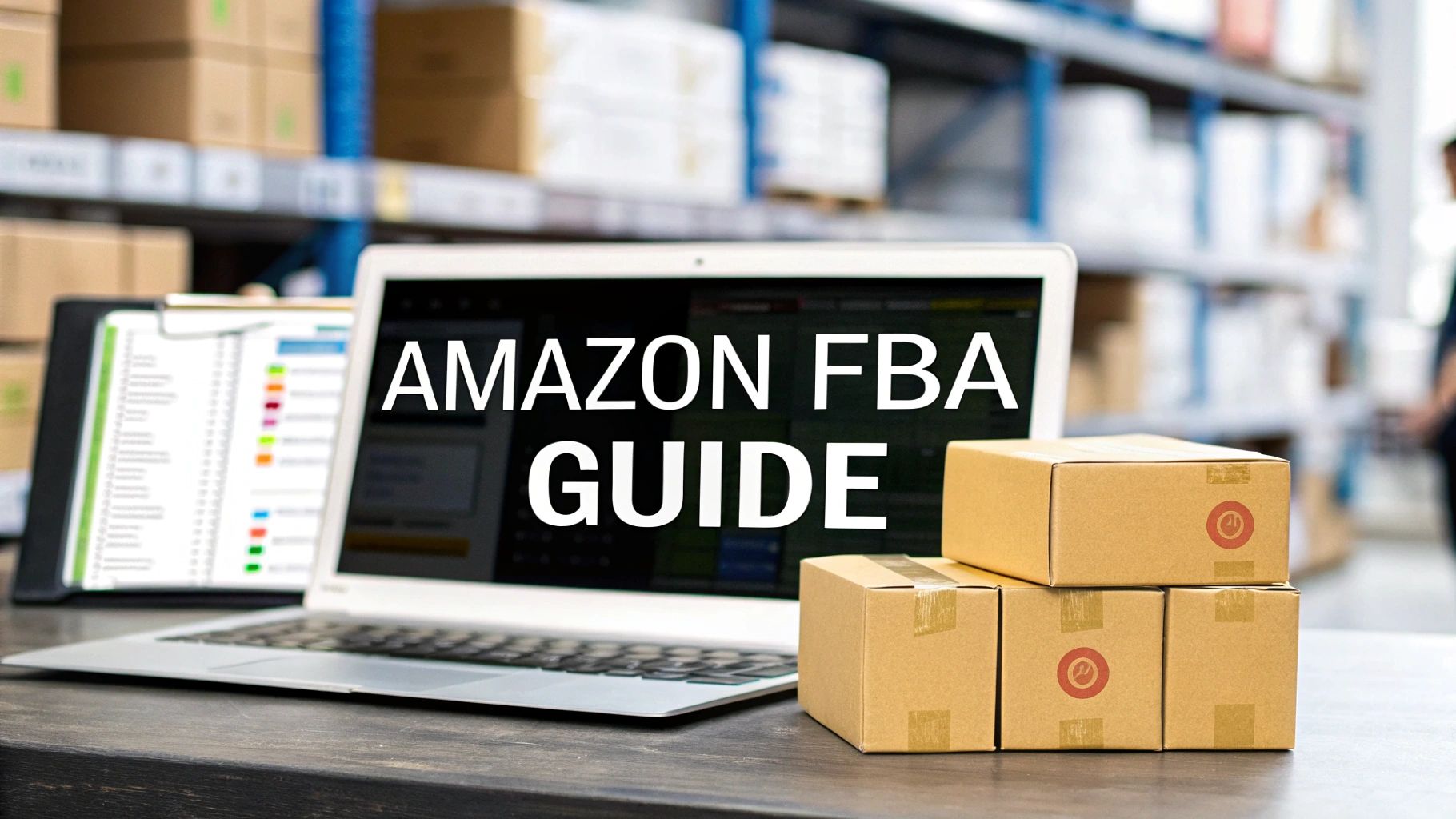
Chilat Doina
July 16, 2025
So, what exactly is Fulfillment by Amazon, or FBA as you’ll hear it called? Think of it as Amazon stepping in to handle all the tricky logistics of your business. In a nutshell, you’re in charge of selling the products, and Amazon takes care of storing, packing, and shipping them to your customers.
Every Amazon seller faces a fundamental choice right from the start: how will you get your products into customers' hands? This decision boils down to two main models: Fulfillment by Amazon (FBA) and Fulfillment by Merchant (FBM).
Choosing FBA means you're essentially partnering with Amazon's massive, world-class logistics network. You ship your products in bulk to an Amazon warehouse, and they handle the rest. This frees you from the daily grind of packing boxes in your garage and making endless trips to the post office. It allows you to focus on the parts of the business that actually drive growth:
On the other hand, with FBM, you're the one in control of the entire fulfillment process. You store your own inventory, pack each order as it comes in, and ship it directly to the customer. This gives you more hands-on control but also means you're responsible for every step, including customer service for shipping inquiries.
To make this crystal clear, let's break down the key differences side-by-side.
This table gives a quick overview of how the two models stack up against each other.
Ultimately, the choice between FBA and FBM depends entirely on your business goals, product type, and how hands-on you want to be.
The sheer scale of the Amazon marketplace is hard to wrap your head around. As of early 2025, there are 9.7 million sellers on the platform worldwide, with over 1.1 million new entrepreneurs joining in the last year alone.
What’s really telling is that a staggering 82% of active sellers use FBA. That’s not a coincidence. It highlights just how essential the program is for sellers who want to scale and compete effectively.
For most sellers, the biggest win is instant access to Prime eligibility. The moment your products are enrolled in FBA, they get that coveted Prime badge. This is a massive signal of trust to millions of loyal Prime members who expect fast, free shipping. Just having that badge can dramatically increase your product's visibility and sales.
This infographic paints a clear picture of FBA's impact, from its adoption rate to its direct effect on sales.
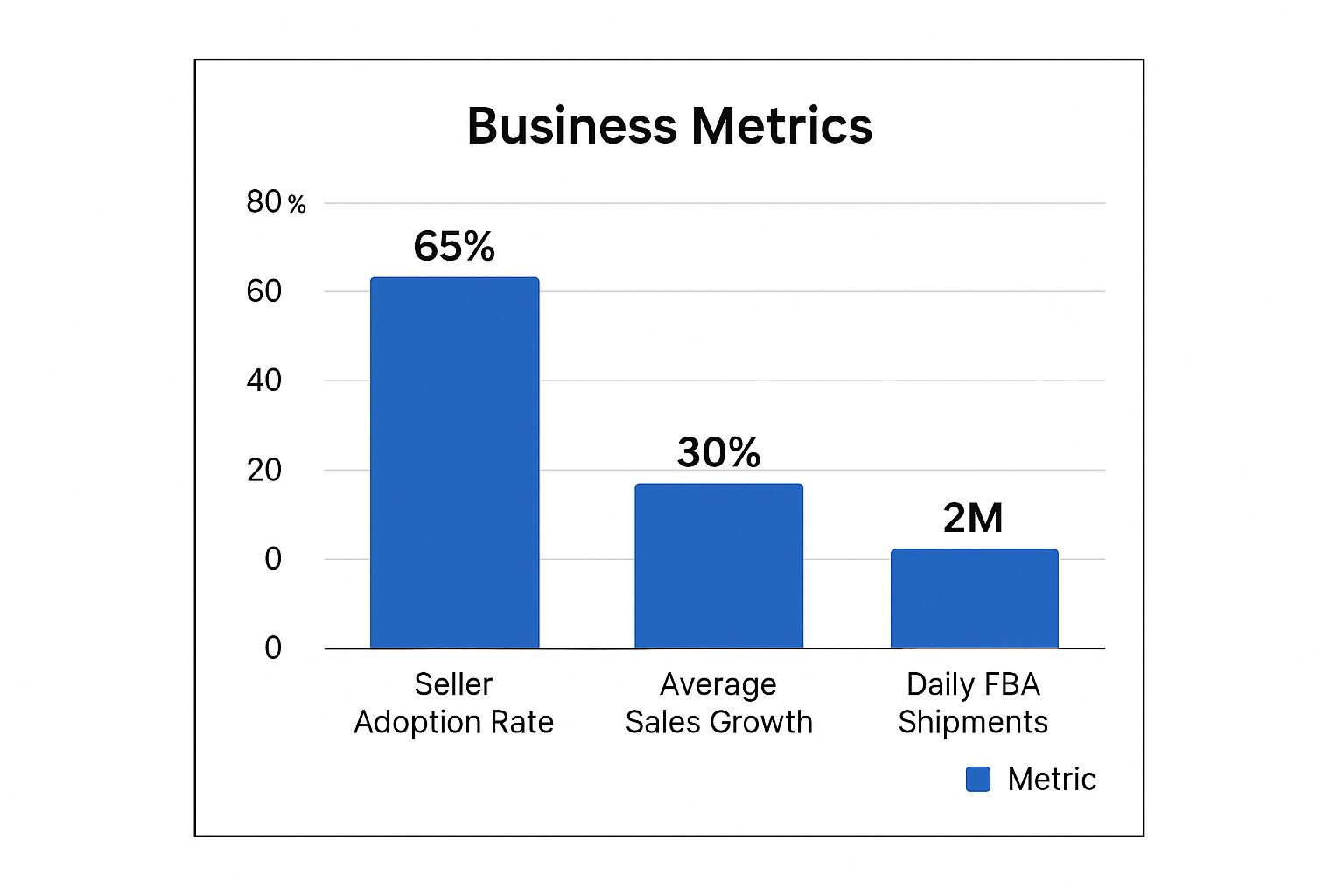
The numbers don't lie. FBA isn't just a popular fulfillment option; it's a proven engine for growth.
This operational freedom is the primary reason so many entrepreneurs choose FBA. It allows a small business to compete on a level playing field with much larger companies, leveraging Amazon’s infrastructure without massive upfront investment.
We’ve laid out the foundational choices, but this is just the beginning. To go deeper on best practices and operational details, check out this excellent guide for Amazon FBA sellers. Let's keep moving and explore what comes next.
Let's be honest, for most people starting an e-commerce business, the biggest headache isn't finding a cool product. It's the logistics. Where do you store everything? How do you pack it all? Who handles the shipping? It's a logistical nightmare that can quickly overwhelm a new entrepreneur.
This is exactly where Fulfillment by Amazon (FBA) comes in and completely changes the game. Think of it less as a service and more like your business on easy mode, instantly plugging you into Amazon's world-class operational machine.
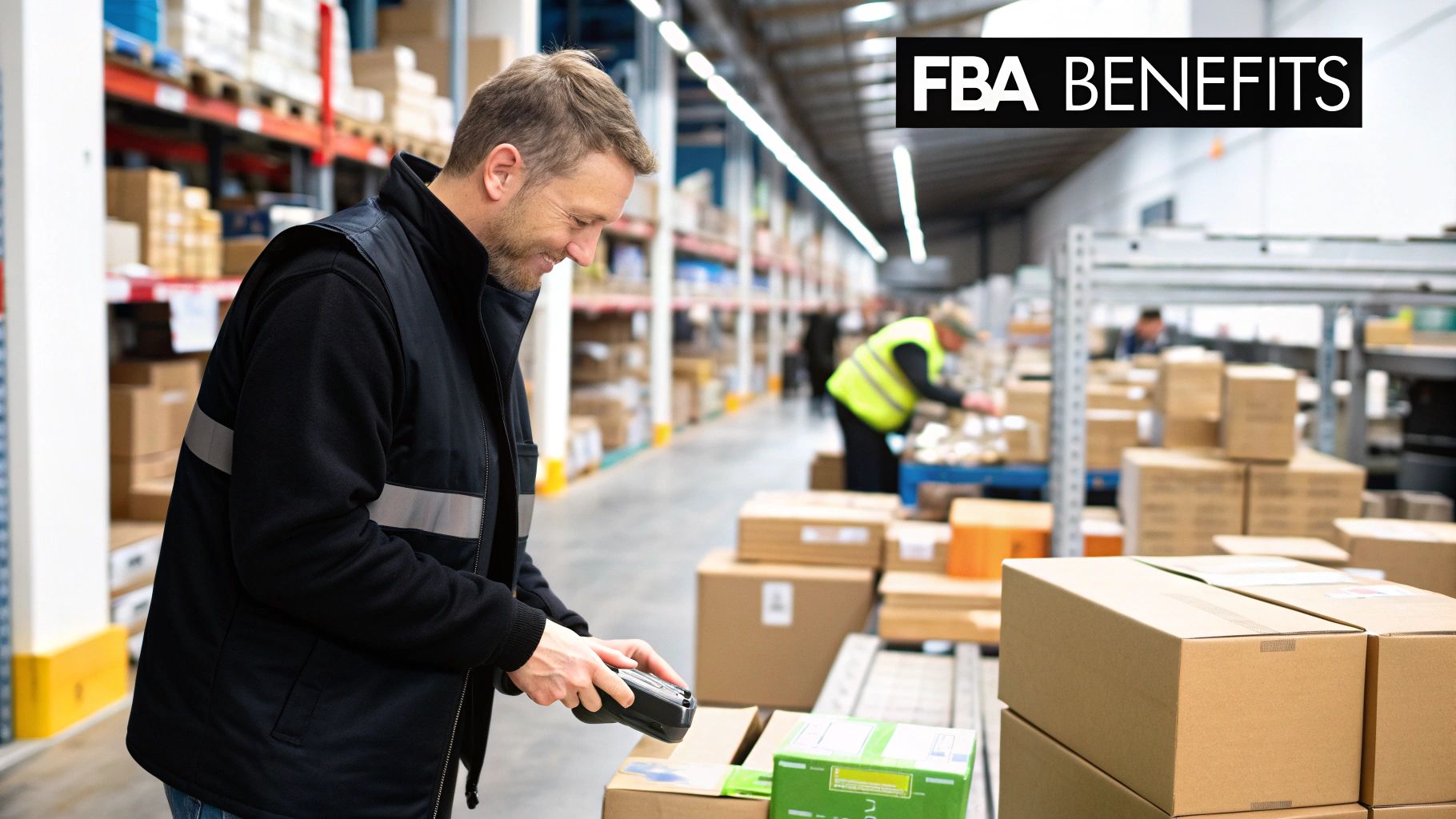
Instead of cramming your garage or living room with boxes, packing tape, and shipping labels, you simply send your products in bulk to an Amazon fulfillment center. Once your inventory arrives, Amazon's finely tuned system of people and robots takes over. They pick, pack, and ship every single order directly to your customers.
This hands-off approach is a massive advantage for FBA sellers on Amazon. Suddenly, a one-person startup can offer the same lightning-fast delivery and reliability as a huge corporation, completely leveling the playing field.
If there's one golden ticket in the world of Amazon, it's the Prime badge. Using FBA is the fastest way to get it. That little blue checkmark next to your product is a powerful signal of trust and convenience for over 200 million Prime members worldwide who specifically filter their searches for that fast, free shipping they love.
When your products get that Prime badge, they instantly become more attractive and visible. Shoppers are hardwired to look for it, often skipping right past listings that don't have it. The result is a direct, measurable boost to your sales and conversion rates.
For many shoppers, if it's not on Prime, it might as well not be on Amazon. FBA is the key that unlocks this massive, high-spending customer base, making it an indispensable tool for serious sellers.
And it goes beyond just shipping. Amazon also takes over customer service and returns for your FBA orders. If a customer has a question about a delivery or needs to make a return, Amazon's 24/7 support team handles it. This not only saves you a ton of time but also protects your brand's reputation, freeing you up to focus on what really grows your business—finding great products and marketing them.
The numbers don't lie. FBA isn't just a popular choice; it's the cornerstone of modern Amazon selling strategy. An estimated 82% of active Amazon sellers are expected to use FBA in 2025. This is especially true for private-label brands, where a staggering 92% rely on Amazon's logistics network.
This overwhelming preference is driven by the huge operational efficiencies and the trust that Prime delivery builds with customers. You can dive deeper into the data on FBA's global adoption and its impact on seller profitability to see just how dominant it is.
This isn't just a passing trend; it's a proven business model. By outsourcing the most time-consuming parts of e-commerce, you get back your most precious resource: time.
This lets you focus on the high-impact tasks that actually move the needle:
At the end of the day, FBA isn't just a fulfillment service. For countless FBA sellers on Amazon, it's the engine that makes sustainable growth possible, turning a simple business idea into a thriving, scalable enterprise.
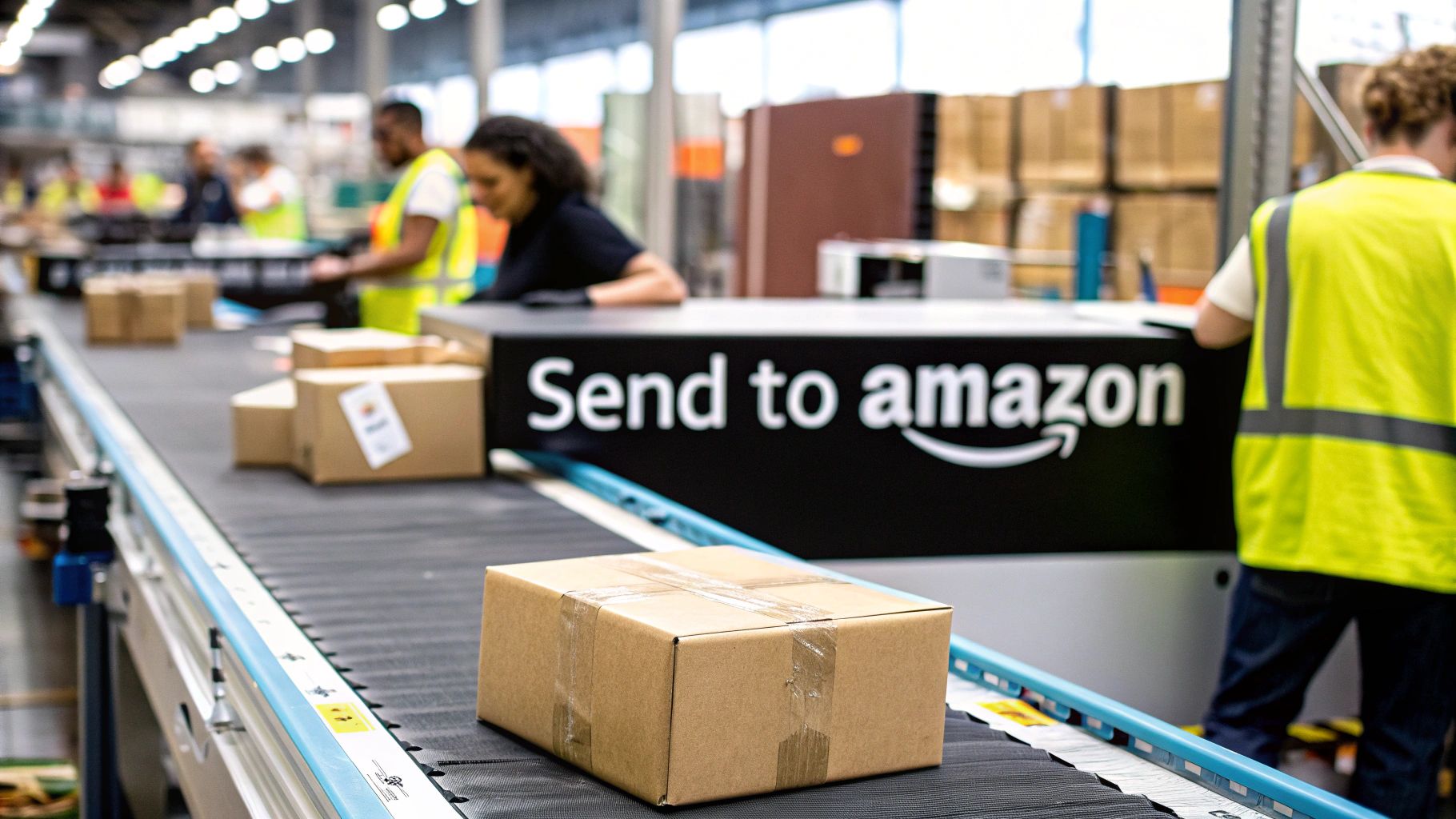
Alright, let's move from theory to action. Turning that great idea into a real, money-making FBA business involves a few key steps. This is where the rubber meets the road, and it all starts with building the command center for your operation: your Amazon Seller Central account.
Right out of the gate, you'll face your first decision: the Individual or Professional selling plan. The Individual plan is perfect if you just want to dip your toes in the water. You pay a simple $0.99 fee for every item you sell, with no monthly subscription. But if you know you’ll be selling more than 40 items a month, the Professional plan is a no-brainer. For a flat $39.99 monthly fee, you unlock a whole suite of essential tools—advanced reporting, advertising, and access to sell in restricted categories.
Most serious FBA sellers on Amazon graduate to the Professional plan pretty quickly. Think of it like this: the Individual plan is a basic cash box, while the Professional plan is a full-blown point-of-sale system that gives you the data and firepower you need to actually grow.
Once your account is live, the real work begins. It’s time for the product hunt. I can't overstate how critical this stage is. The right product can put your business on the fast track, while the wrong one will have you spinning your wheels before you even get started.
Product research today is less about guesswork and more about data. The goal is to find that sweet spot: a product with hungry buyers but not a ton of sellers fighting over them. This is how you minimize risk and give yourself the best shot at getting seen and making sales.
Don't just randomly browse. Start with categories you're actually interested in, then use solid research tools to see if your ideas have legs. You're looking for a few key signs of a healthy niche:
This part takes patience. You’re essentially becoming a detective, digging through Amazon's massive catalog to uncover a customer pain point you can solve better than anyone else.
Once you’ve nailed down what to sell, you have to figure out where to get it. Most FBA sellers on Amazon fall into one of three main sourcing camps, and each has its own vibe.
Finding a supplier you can trust is absolutely non-negotiable. For private label, sites like Alibaba are a popular place to start, but you have to do your homework. For wholesale, you'll be reaching out to distributors and brands directly. Always, always get samples, verify their business licenses, and place a small test order first. You have to be sure the quality is there before you sink a bunch of cash into inventory.
Okay, you've got your product and your supplier. The last piece of the puzzle is getting your inventory into Amazon's hands. You’ll do this by creating a shipment plan inside Seller Central. This is basically your instruction manual for Amazon, telling them exactly what's coming, how many units, and how it’s all packed.
The process itself is pretty straightforward, but the details matter. You'll enter product dimensions, weights, and note any special prep needed (like putting items in a poly bag or wrapping them in bubble wrap). Amazon’s system will then assign your shipment to one or more fulfillment centers. Follow their labeling and packaging rules to the letter—it’s the key to avoiding headaches, delays, or even having your shipment rejected at the warehouse door.
A brilliant product is completely invisible without a listing that stops a scrolling customer dead in their tracks. If you’re an FBA seller on Amazon, your product detail page isn't just a description; it's your tireless, 24/7 digital salesperson. Nailing this part is the difference between sluggish sales and a best-seller badge.
Think of your listing as the bridge connecting a customer's problem to your product's solution. Every single element—from the title down to the very last photo—has to work in harmony to build trust, answer questions before they're even asked, and gently guide the shopper toward that "Add to Cart" button. It's a real blend of science and art, mixing strategic keyword placement with compelling, benefit-driven storytelling.
Your listing is built from several key pieces, and each one has a specific job to do. Neglecting even one of them is like trying to run a race with only one shoe on. To truly stand out, every part needs to be firing on all cylinders.
Product Title: This is your most valuable real estate on the page. It absolutely must include your main keyword, your brand name, and the most critical features or benefits. A great title tells both the customer and Amazon's A9 algorithm exactly what your product is and why they should care.
Bullet Points (Key Product Features): This is where you really sell the dream. Don't just list out dry features; you have to translate them into real-world benefits. Instead of saying "100% Cotton," try "Breathable 100% Cotton for a Cool, Comfortable Night's Sleep." Each bullet point should tackle a potential customer question or pain point head-on.
Product Images and Video: We’re visual creatures. In fact, a recent report showed that a staggering 75% of online shoppers depend on product photos when deciding whether to buy. Your images have to be professional, high-resolution, and show the product from every conceivable angle. Make sure to include lifestyle shots showing the product in action and infographics that highlight key benefits. If you want your listings to convert, high-quality visuals are non-negotiable. You can find some easy tips for stunning product photos that will grab a buyer's attention and drive more sales.
Underneath all that compelling copy and those beautiful images lies the technical foundation of your listing: keywords. At its core, Amazon's A9 algorithm is a search engine. To get your product to rank, you have to speak its language. That means strategically placing relevant keywords throughout your title, bullet points, product description, and even in the back-end search term fields.
A classic rookie mistake is "keyword stuffing"—jamming so many keywords into the listing that it becomes an unreadable, spammy mess. The real goal is to weave your keywords in naturally, creating copy that's just as persuasive for people as it is optimized for the algorithm.
This is also where A+ Content (also known as Enhanced Brand Content for Brand Registered sellers) completely changes the game. It lets you swap out the boring, standard text description for a visually rich layout of slick images, comparison charts, and branded storytelling modules. Using A+ Content can boost conversion rates by an average of 5-10% simply because it builds brand trust and helps customers truly visualize your product in their own lives. Our in-depth guide offers a full breakdown of the tactics top sellers use for Amazon listing optimization.
To make sure you've covered all your bases before going live, run through this simple checklist. It's a quick and easy way to double-check your work and catch any missed opportunities that might be costing you sales down the line.
Here’s a quick rundown of the essentials for a high-converting listing.
At the end of the day, a winning listing is a living document, not a "set it and forget it" task. You should constantly be testing different titles, swapping out images, and refining your bullet points based on customer questions and feedback. For FBA sellers on Amazon, that commitment to continuous optimization is what will keep you ahead of the competition and turn those clicks into loyal, repeat customers.
Alright, your products are live on Amazon and your listings are looking sharp. What now? This is where the real work begins. Your focus shifts from simply launching to actively managing and growing your FBA business. This phase is all about turning that initial momentum into a profitable, long-term venture.
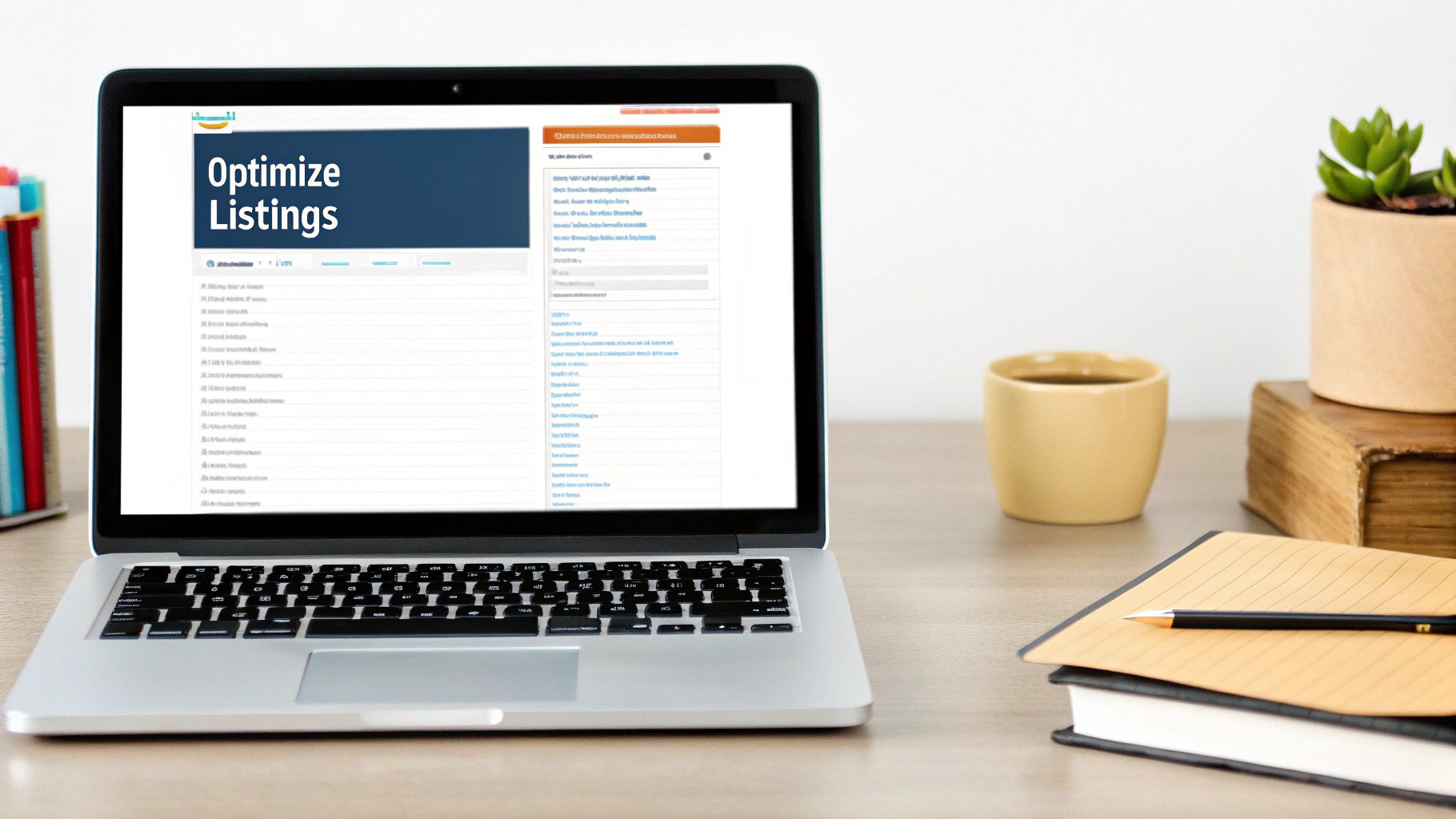
You're no longer just a seller; you're a business operator. Your day-to-day will be a cycle of monitoring performance, keeping a close eye on inventory, driving traffic, and making smart, data-backed decisions. Nailing these operational pillars is what separates the businesses that thrive from the ones that fizzle out.
Inventory management is the absolute heartbeat of a healthy FBA business. Get it wrong, and you'll feel the pain. Too much stock ties up your cash and has you paying Amazon's costly long-term storage fees. Too little, and you'll stock out, killing your sales velocity and tanking your product ranking. It’s a constant balancing act.
Amazon gives you a crucial tool for this: the Inventory Performance Index (IPI) score in Seller Central. This single number offers a snapshot of your inventory health, looking at things like your sell-through rate and if you have too much excess inventory. Keeping your IPI score high is critical. Let it drop, and Amazon might slap you with storage limits and higher fees.
Think of your IPI score as your FBA credit score. A good score unlocks more storage space and keeps your costs down. A bad one can seriously hamstring your ability to operate. Proactive management is the only game in town.
Seasoned FBA sellers on Amazon blend Amazon's forecasting tools with their own sales history to get a real feel for demand. They figure out their reorder points and lead times so new stock lands just as the old batch is running low. It's all about creating that seamless flow to keep the sales engine humming.
Having the perfect product with perfectly managed inventory doesn't mean a thing if shoppers can't find you. That’s where Amazon Pay-Per-Click (PPC) advertising enters the picture. It's the most direct lever you can pull to get targeted eyeballs on your product listings.
When you run a PPC campaign, you're essentially bidding on keywords. If a customer searches for one of your keywords, your product can show up in those sponsored spots right at the top of the search results. The best part? You only pay when someone actually clicks your ad.
A simple, effective way to get started is by running two campaign types:
Start with a small daily budget and keep a close watch on your Advertising Cost of Sale (ACoS). This will make sure your campaigns are actually making you money, not just costing you. For a deeper dive into this, our guide on how top Amazon FBA sellers scale their business has some next-level strategies.
Long-term success isn’t just about making sales; it’s about protecting what you’ve built. That’s why checking your Account Health dashboard in Seller Central needs to be a non-negotiable part of your routine. This dashboard is your report card on how well you're following Amazon's rules, from customer service to policy compliance.
Ignoring warnings here is playing with fire and can lead to serious consequences. Even the most careful sellers can run into trouble. If the worst happens, it's good to know there are expert tips to reclaim a suspended Amazon account that can help get you back online.
Finally, scaling is all about letting data guide your decisions. Get comfortable inside your Business Reports in Seller Central. This is where you'll find gold, like your traffic, conversion rates, and session data. Are people finding you but not buying? Your listing might need some work. Is traffic low? Maybe it’s time to rethink your PPC or keyword strategy. This data-driven feedback loop is the key to sustainable growth for all FBA sellers on Amazon.
Once your FBA business is humming along nicely, it's time to make a crucial shift. Stop just managing operations and start building a brand that's tough to beat. This is where you graduate from the basics and begin creating a competitive moat around your business, making it much harder for new sellers to crowd your space.
These next-level tactics definitely take more work, but the payoff is exponentially bigger. They're the real secret to long-term growth and carving out your territory in a packed marketplace. This is the playbook successful FBA sellers on Amazon follow to truly scale.
If there's one move that changes everything, it's enrolling in Amazon Brand Registry. This program is for sellers with a registered trademark, and it unlocks a treasure chest of tools designed to protect your brand and seriously upgrade your marketing game.
Think of Brand Registry as your brand’s personal security detail and marketing agency, all in one. On one hand, it gives you powerful tools to find and shut down counterfeit listings, giving you firm control over who sells your products. But the real magic is in the marketing features it opens up.
Brand Registry isn't just a defensive shield anymore; it’s an offensive playbook. It grants you access to A+ Content, Sponsored Brands ads, and Amazon Storefronts—all critical for telling a rich brand story and connecting directly with customers.
These are the tools that let you transform your listing from just another product on a page into a genuine, memorable brand that shoppers start searching for by name.
Standard Sponsored Products campaigns are fantastic for getting those initial sales. But to really scale, you need to layer your advertising strategy. Once you're in Brand Registry, you get access to more sophisticated ad types that build awareness and snag customers at every point in their shopping journey.
When you use these ad types together, you create a full-funnel machine. Sponsored Brands builds awareness at the top, Sponsored Products captures ready-to-buy shoppers in the middle, and Sponsored Display re-engages anyone who showed interest, closing the loop at the bottom.
The final pillars of next-level growth are all about not putting all your eggs in one basket. Relying on a single "hero" product is a risky game. The smartest FBA sellers on Amazon are always hunting for ways to diversify their catalog by launching complementary products their current customers will love. This move boosts the lifetime value of each customer and spreads your risk across multiple income streams.
At the same time, you should be thinking about taking your brand worldwide with Amazon Global Selling. The program makes it surprisingly straightforward to list your products on Amazon's international marketplaces in Europe, Asia, and beyond. Suddenly, your brand is available to millions of new customers.
Yes, it means navigating new tax and compliance rules, but for a brand that has already found its footing, the potential for growth is massive. This is how you go from being a successful domestic seller to a global e-commerce powerhouse.
Diving into the world of Amazon FBA always stirs up a few big questions. If you're thinking about becoming an FBA seller on Amazon, you need to get real about the costs, the time commitment, and the hurdles you'll inevitably face. Getting this straight from the start is key to setting yourself up for success.
Let's cut through the noise and tackle the questions we hear most often.
This is the big one, and the honest answer is: it depends. A lot of people get hooked on the idea that you can launch a business with just a few hundred bucks. While that might be technically possible with something like retail arbitrage, it’s not a serious strategy for building a real brand.
For a private label or wholesale business, you should be looking at an initial investment of $3,500 to $5,000. That might sound like a lot, but here’s where that money goes:
Trying to skate by on too little cash is one of the fastest ways to fail. It gives you zero wiggle room for mistakes or for reinvesting in more inventory when things start to take off.
Get ready to play the long game. While you'll hear exciting stories of sellers hitting profitability in their first six months, a more realistic timeline is closer to 9 to 12 months. The actual time depends on your product's niche, your profit margins, and how aggressively you reinvest your early revenue.
Most serious sellers don't take a dime out of the business for the first year. Every dollar of revenue goes right back into buying more inventory and scaling ad campaigns. It's a strategy that builds a much stronger foundation for long-term growth.
Think of your first year as an apprenticeship. You're learning the rhythm of your sales, figuring out inventory, and getting a feel for Amazon's ecosystem. Expect to grind it out before you start seeing a consistent paycheck.
Every new seller stumbles over the same few obstacles. Knowing what they are ahead of time gives you a massive advantage. Here are the most common ones:
Navigating these challenges is much easier when you're surrounded by people who've already figured it out. In Million Dollar Sellers, you get direct access to the strategies and insights of 7-, 8-, and 9-figure entrepreneurs who have mastered the FBA landscape. Learn more about how MDS helps you scale smarter and faster.
Join the Ecom Entrepreneur Community for Vetted 7-9 Figure Ecommerce Founders
Learn MoreYou may also like:
Learn more about our special events!
Check Events